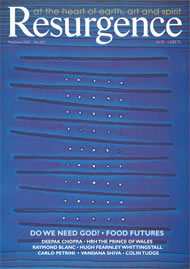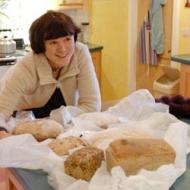THERE WE WERE, aproned-up and attentive. Eleven of us, each with a fair trade cotton cap that stated ‘Bread Matters’.
For two days the conversation rarely deviated from bread. I wouldn’t have thought it possible, or even advisable … but somehow it was compulsive. I blame the teacher – heartily and happily. Never before had I been able to explore so many avenues on one of my favourite topics – bread and breadmaking – so richly. Andrew Whitley, founder of The Village Bakery, who now runs the Bread Matters courses, can be easily diverted down any bread-related lane. His eyes light up, his delivery is rapid and soon we’re off, trotting at a brisk pace, while he describes the bread-making terrain. Be it the industrialisation of agriculture, gluten intolerance or the notion of food poverty, he is well versed and fascinating.
Whitley is not your average baker. For one, he proudly admits he is untrained, and as a result hasn’t been exposed to the conventions of the baking industry and their “sad deceptions and underhand tricks (such as additives, improvers, colours and flavouring)”. His path to bread was an interesting one: his first incarnation was a BBC Russian Service producer in London, who found reprieve from city life by growing wheat on his
allotment in Stoke Newington. In 1976, he escaped the rat-race and teamed-up with a friend who had renovated a watermill near Penrith, in Cumbria. There he started his self-taught baking apprenticeship by making organic breads, cakes and scones for the watermill tearoom. This eventually evolved into a business – The Village Bakery. For more than two decades he was the only serious British baker using renewable energy by baking in wood-fired brick ovens.
WHEN ANDREW’S BOOK, Bread Matters arrived on our desk at Resurgence I idly thumbed through it. I’d come across The Village Bakery a while back, and had never found a better rye bread than their famous ‘Borodinsky’, so I expected the book to be full of good recipes. It was that, but much more. The opening paragraph of Chapter Three ‘Taking Control’ caught me off guard, and I knew this book was more than the usual re-jigging of ingredients.
“British bread is a nutritional, culinary, social and environmental mess – made from aggressively hybridised wheat that is grown in soils of diminishing natural fertility, sprayed with toxins to counter pests and diseases, milled in a way that robs it of the best part of its nutrients … and made into bread using a cocktail of functional additives and a super-fast fermentation (based on greatly increased amounts of yeast), which inhibits assimilation of some of the remaining nutrients while causing digestive discomfort to many consumers.” Those few lines powerfully summed up most of my suspicions and bits of gleaned information over the past few years. That short paragraph left me with no doubts. I booked a bread course immediately – ‘Sourdough for All’.
My current estimate is that every third person I meet complains of some kind of intolerance to wheat, usually manifesting itself as bloating and stomach discomfort. Suffering from the same problem, I’m always interested and probe a bit more. On the course I learnt that the Institute for Optimum Nutrition conducted a survey of 37,000 people, over 67% of whom complained of regular abdominal bloating. So it’s not just me – there is a growing trend. Most of the sufferers I meet have resorted to giving up most wheat breads, and only eating rye. Rye bread is usually made using a long sourdough fermentation, developing the wild yeasts already present in the flour (instead of industrial baker’s yeast). The long fermentation also gives time for lactobacillus bacteria to develop, which ‘pre-digests’ some of the starches in the flour, producing breads with superior digestibility. The combined action of the wild yeasts and lactobacillus on the flour also produces breads with wonderful flavour and texture.
Sourdough baking is the most ancient and basic of baking methods; it begins by mixing flour and water together and leaving it in a warm place to create a sourdough ‘starter’. This provides the impetus for the wild yeasts and lactobacillus bacteria in the flour to begin multiplying, starting a slow fermentation. This living culture is the baker’s future and past in one: most of it is used in each baking, but a small handful is kept back to provide the starter for the next batch of bread. This method can be used with different types of grain (though it is most commonly associated with rye) – as a result I found myself able to tuck into a wheat loaf for the first time in years, without any subsequent discomfort.
Sourdough baking, though simple, takes time and patience – elements that are sadly lacking from our modern bread-making process. Today most wheat breads are forced to rise in a short time using a large injection of baker’s yeast and sugar. This allows most baking processes to cut the fermentation (or ‘rising’ time) to a minimum, which ultimately means more loaves through the bakery per hour: a faster turnover and more profit. The consequence is that the yeasts haven’t had time to properly work on and digest the wheat protein, so the bread might look perfectly risen, but internally it has suffered. Hardly surprising then that so many people find this type of bread hard to digest.
I believe that this is one of the most hidden health problems today. Modern bread is making us ill, and too often we are sent away from doctor’s surgeries being told that we are suffering from Irritable Bowel Syndrome (IBS) – a blanket term for a whole host of digestion problems possibly brought about by the unchecked growth of candida albicans, which feasts on the excess of sugars and yeasts found in today’s industrialised food. One way to get back on the train of health is to start eating (and, better still, baking) properly fermented breads, starting with rye sourdoughs.
“HANDS UP THOSE of you who’ve heard of Rachel Carson.” Three out of eleven hands stretched up. Hearing those words, I knew that this was going to be a bread course with philosophical depth. Not everyone appreciated this level of horizon, preferring to focus on the immediate tasks in hand – ingredients, mixing, stretching, moulding, baking – but Whitley could switch his attention either way, and placated those who needed guidance with technique, or the new territory of sourdough and its wonderful vocabulary – leavens, yeasts, sponges, flying tops, peels and extensibility.
After all, as on most of his courses, this was a really diverse and stimulating group of people. Some described themselves as explorers, some as searchers; some were at a crossroads in life looking to leap; some were getting back to baking after retirement; others were simply after new techniques and recipes. There was a retired anaesthetist who had a five-year-old rye starter sourdough, which he fondly called Bathsheba and used to carry with him on holiday so he could continue making his rye bread. Another participant was set on retiring to her home town in Oklahoma and setting up a baking business.
Perhaps I spent too much of the course in my head, as on leaving I was presented with seven entirely different loaves of bread – apparently I’d made them all. They looked strangers to me, so to differentiate between the Cypriot arkatena bread and the spelt loaf was a mystery. I could just manage to recognise the baguette and the fruit and nut loaf. However, I was strangely proud of this new family, still warm from the wood-fired oven. What is more, I carried away with me a small piece of history: some of the rye sourdough starter that is used to make Borodinsky bread at The Village Bakery. When I open my fridge I am comforted by the sight of my small glass jar of dark liquid – I smile at the thought that it contains descendants of the original ‘mother’ starter that Whitley was given as a gift from a Russian bakery seventeen years ago – and which he smuggled back to England in his sock.
For more information on Bread Matters baking courses tel: +44 (0)1768 881899 or visit www.breadmatters.com







